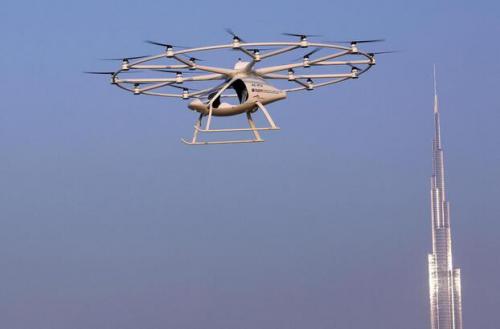Hargrave's Kite ExperimentsAfter experimenting with very many models and building no less thaneighteen monoplane flying model machines, actuated by rubber, bycompressed air and by steam, Mr Lawrence Hargrave, of Sydney, NewSouth wales invented the cellular kite which bears his name and made itknown in a paper contributed to the Chicago Conference on AerialNavigation in 1893, describing several varieties. The modem constructionis well known, and consists of two cells, each of superposed surfaces withvertical side fins, placed one behind the other and connected by a rod orframe. This flies with great steadiness without a tail. Mr. Hargrave's ideawas to use a team of these kites, below which he proposed to suspend amotor and propeller from which a line would be carried to an anchor in theground. Then by actuating the propeller the whole apparatus would moveforward, pick up the anchor and fly away. He said: The next step is clearenough, namely, that a flying machine with acres of surface can be safelygot under way or anchored and hauled to the ground by means of thestring of kitesThe first tentative experiments did not result well and emphasized thenecessity for a light motor, so that Mr. Hargrave has since been engaged indeveloping one, not having convenient access to those which have beenproduced by the automobile designers and buildersExperiments With Glider Model.And here a curious reminiscence may be indulged in. In 1888 thepresent writer experimented with a two-cell gliding model, preciselysimilar to a Hargrave kite, as will be confirmed by Mr. Herring. It wasfrequently tested by launching from the top of a three-story house andglided downward very steadily in all sorts of breezes. but the angle ofdescent was much steeper than that of birds, and the weight sustainedsquare foot was less than with single cells, in consequence of the lessersupport afforded by the rear cell, which operated upon air already setmotion downward by the front cell so nothing more was done with it forit never occurred to the writer to try it as a kite and he thus missed thedistinction which attaches to hargrave's name

Sir Hiram Maxim also introduced fore and aft superposed surfaces nhis wondrous flying machine of 1893. but he relied chiefly for the liftupon his main large surface and this necessitated so many guys, to preventdistortion, as greatly to increase the head resistance and this, together withthe unstable equilbrium, made it evident that the design of the machinewould have to be changedHow Lilienthal Was KilledIn 1895, Otto Lilienthal, the father of modem aviation, the man towhose method of experimenting almost all present successes are due, aftermaking something like two thousand glides with monoplanes, added asuperposed surface to his apparatus and found the control of it muchmproved. The two surfaces were kept apart by two struts or vertical postswith a few guy wires, but the connecting joints were weak and there wasnothing like trussing. This eventually cost his most useful life. Two weeksbefore that distressing loss to science, Herr Wilhelm Kress, thedistinguished and veteran aviator of vienna. witnessed a number of glidesby Lilienthal with his double-decked apparatus. He noticed that it wasmuch wracked and wobbly and wrote to me after the accident:"Thconnection of the wings and the steering arrangement were very baunreliable. I warned Her Lilienthal very seriously. He promised me thathe would soon put it in order, but I fear that he did not attend to itimmediatelyIn point of fact, Lilienthal had built a new machine, upon a differentprinciple, from which he expected great results, and intended to make butvery few more flights with the old apparatus. He unwisely made one toomany and, like Pilcher, was the victim of a distorted apparatus. Probablyone of the joints of the struts gave way, the upper surface blew back andLilienthal, who was well forward on the lower surface, was pitchedheadlong to destruction.
Experments by the WriterIn 1896, assisted by Mr. Herring and Mr. Avery, I experimented withseveral full sized glding machines, carrying a man. The first was aLilienthal monoplane which was deemed so cranky that it was discardedafter making about one hundred glides, six weeks before Lilienthalsaccident The second was known as the multiple winged machine andfinally developed into five pairs of pivoted wings, trussed together at thefront and one pair in the rear. It gilded at angles of descent of 10 or 11degrees or of one in five, and this was deemed too steep. Then Mr Hemingand myself made computations to analyze the resistances. We attributedmuch of them to the five front spars of the wings and on a sheet of cross-barred paper I at once drew the design for a new three-decked machine tobe built by mr hemingBeing a builder of bridges. I trussed these surfaces together. in order toobtain strength and stiffness. When tested in gliding flight the lowersurface was found too near the ground. It was taken off and the remainingapparatus now consisted of two surfaces connected together by a girdercomposed of vertical posts and diagonal ties, specifically known as aPratt truss. Then Mr. Herring and Mr. Avery together devised and put onan elastic attachment to the tail. This machine proved a success, it beingsafe and manageable. Over 700 glides were made with it at angles ofdescent of 8 to 10 degrees or one in six to one in seven.First Proposed by Wenham.The elastic tail attachment and the trussing of the connecting frame ofe superposed wings were the only novelties in this machine, for theuperposing of the surfaces had first been proposed by Wenham, but maccordance with the popular perception, which bestows all the credit uponthe man who adds the last touch making for success to the labors of hispredecessors, the machne has since been known by many persons as the
